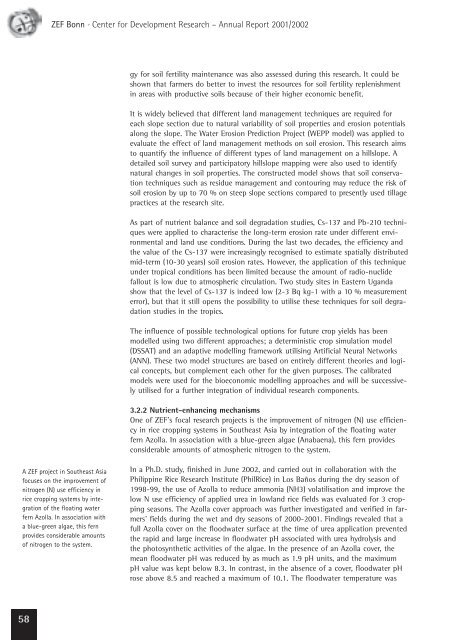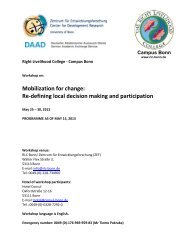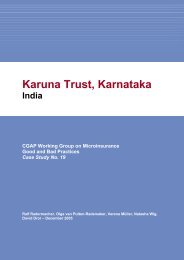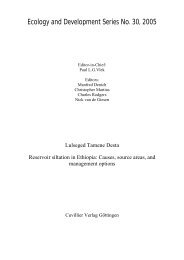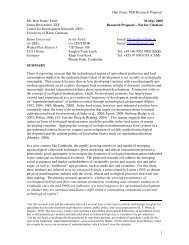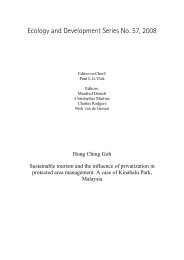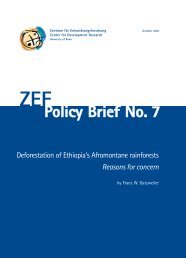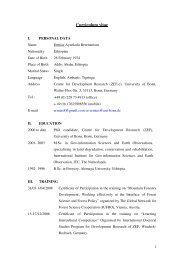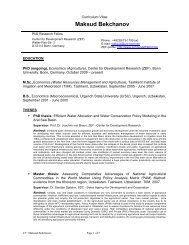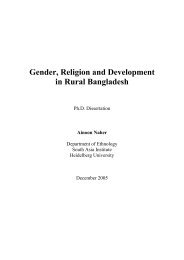ZEF Bonn
ZEF Bonn
ZEF Bonn
You also want an ePaper? Increase the reach of your titles
YUMPU automatically turns print PDFs into web optimized ePapers that Google loves.
58<br />
<strong>ZEF</strong> <strong>Bonn</strong> ● Center for Development Research – Annual Report 2001/2002<br />
A <strong>ZEF</strong> project in Southeast Asia<br />
focuses on the improvement of<br />
nitrogen (N) use efficiency in<br />
rice cropping systems by integration<br />
of the floating water<br />
fern Azolla. In association with<br />
a blue-green algae, this fern<br />
provides considerable amounts<br />
of nitrogen to the system.<br />
gy for soil fertility maintenance was also assessed during this research. It could be<br />
shown that farmers do better to invest the resources for soil fertility replenishment<br />
in areas with productive soils because of their higher economic benefit.<br />
It is widely believed that different land management techniques are required for<br />
each slope section due to natural variability of soil properties and erosion potentials<br />
along the slope. The Water Erosion Prediction Project (WEPP model) was applied to<br />
evaluate the effect of land management methods on soil erosion. This research aims<br />
to quantify the influence of different types of land management on a hillslope. A<br />
detailed soil survey and participatory hillslope mapping were also used to identify<br />
natural changes in soil properties. The constructed model shows that soil conservation<br />
techniques such as residue management and contouring may reduce the risk of<br />
soil erosion by up to 70 % on steep slope sections compared to presently used tillage<br />
practices at the research site.<br />
As part of nutrient balance and soil degradation studies, Cs-137 and Pb-210 techniques<br />
were applied to characterise the long-term erosion rate under different environmental<br />
and land use conditions. During the last two decades, the efficiency and<br />
the value of the Cs-137 were increasingly recognised to estimate spatially distributed<br />
mid-term (10-30 years) soil erosion rates. However, the application of this technique<br />
under tropical conditions has been limited because the amount of radio-nuclide<br />
fallout is low due to atmospheric circulation. Two study sites in Eastern Uganda<br />
show that the level of Cs-137 is indeed low (2-3 Bq kg-1 with a 10 % measurement<br />
error), but that it still opens the possibility to utilise these techniques for soil degradation<br />
studies in the tropics.<br />
The influence of possible technological options for future crop yields has been<br />
modelled using two different approaches; a deterministic crop simulation model<br />
(DSSAT) and an adaptive modelling framework utilising Artificial Neural Networks<br />
(ANN). These two model structures are based on entirely different theories and logical<br />
concepts, but complement each other for the given purposes. The calibrated<br />
models were used for the bioeconomic modelling approaches and will be successively<br />
utilised for a further integration of individual research components.<br />
3.2.2 Nutrient-enhancing mechanisms<br />
One of <strong>ZEF</strong>'s focal research projects is the improvement of nitrogen (N) use efficiency<br />
in rice cropping systems in Southeast Asia by integration of the floating water<br />
fern Azolla. In association with a blue-green algae (Anabaena), this fern provides<br />
considerable amounts of atmospheric nitrogen to the system.<br />
In a Ph.D. study, finished in June 2002, and carried out in collaboration with the<br />
Philippine Rice Research Institute (PhilRice) in Los Baños during the dry season of<br />
1998-99, the use of Azolla to reduce ammonia (NH3) volatilisation and improve the<br />
low N use efficiency of applied urea in lowland rice fields was evaluated for 3 cropping<br />
seasons. The Azolla cover approach was further investigated and verified in farmers'<br />
fields during the wet and dry seasons of 2000-2001. Findings revealed that a<br />
full Azolla cover on the floodwater surface at the time of urea application prevented<br />
the rapid and large increase in floodwater pH associated with urea hydrolysis and<br />
the photosynthetic activities of the algae. In the presence of an Azolla cover, the<br />
mean floodwater pH was reduced by as much as 1.9 pH units, and the maximum<br />
pH value was kept below 8.3. In contrast, in the absence of a cover, floodwater pH<br />
rose above 8.5 and reached a maximum of 10.1. The floodwater temperature was


